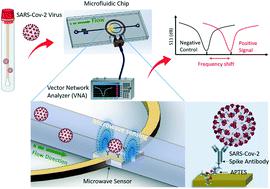Our official English website, www.x-mol.net, welcomes your
feedback! (Note: you will need to create a separate account there.)
Reagent free detection of SARS-CoV-2 using an antibody-based microwave sensor in a microfluidic platform
Lab on a Chip ( IF 6.1 ) Pub Date : 2022-04-19 , DOI: 10.1039/d2lc00145d Weijia Cui 1 , Pei Zhao 1, 2 , Jin Wang 3 , Ning Qin 1, 2 , Emmanuel A Ho 3, 4 , Carolyn L Ren 1, 4
Lab on a Chip ( IF 6.1 ) Pub Date : 2022-04-19 , DOI: 10.1039/d2lc00145d Weijia Cui 1 , Pei Zhao 1, 2 , Jin Wang 3 , Ning Qin 1, 2 , Emmanuel A Ho 3, 4 , Carolyn L Ren 1, 4
Affiliation

|
The global COVID-19 pandemic caused by SARS-CoV-2 has resulted in an unprecedented economic and societal impact. Developing simple and accurate testing methods for point-of-care (POC) diagnosis is crucial not only for the control of COVID-19, but also for better response to similar outbreaks in the future. In this work, we present a novel proof-of-concept of a microfluidic microwave sensing method for POC diagnosis of the SARS-CoV-2 virus. This method relies on the antibody immobilized on the microwave sensor to selectively capture and concentrate the SARS-CoV-2 antigen or virus present in a buffer solution flowing through the sensor region in a microchannel. The capturing of the SARS-CoV-2 antigen or virus results in a change in the permittivity of the medium near the sensor region reflected by the resonance frequency shift which is used for detection. The use of microchannels offers precise control of the sample volume and the continuous flow nature also offers the potential to monitor the dynamic capturing process. The microwave-microfluidic device shows a good sensitivity of 0.1 ng ml−1 for the SARS-CoV-2 antigen and 4000 copies per ml for the SARS-CoV-2 virus. The resonance frequency shift presents a linear relationship with the logarithm of antigen or virus concentration, respectively. This detection method is able to distinguish SARS-CoV-2 from the antigen of human CD4 and two human coronaviruses (MERS and HKU1), which presents a new pathway towards POC diagnosis of the COVID-19 at the community level. It presents the potential to detect other viruses by functionalizing the microwave sensor with respective antibodies.
中文翻译:

在微流控平台中使用基于抗体的微波传感器无试剂检测 SARS-CoV-2
由 SARS-CoV-2 引起的全球 COVID-19 大流行造成了前所未有的经济和社会影响。为即时 (POC) 诊断开发简单而准确的测试方法不仅对于控制 COVID-19 至关重要,而且对于更好地应对未来的类似疫情也至关重要。在这项工作中,我们提出了一种用于 SARS-CoV-2 病毒 POC 诊断的微流控微波传感方法的新概念验证。该方法依靠固定在微波传感器上的抗体选择性地捕获和浓缩存在于缓冲溶液中的 SARS-CoV-2 抗原或病毒,这些缓冲溶液流过微通道中的传感器区域。SARS-CoV-2 抗原或病毒的捕获导致传感器区域附近介质的介电常数发生变化,该变化由用于检测的共振频移所反映。微通道的使用提供了对样品体积的精确控制,并且连续流动性质还提供了监测动态捕获过程的潜力。微波微流体装置显示出 0.1 ng ml 的良好灵敏度SARS-CoV-2 抗原为-1,SARS-CoV-2 病毒为每毫升 4000 个拷贝。共振频移分别与抗原或病毒浓度的对数呈线性关系。该检测方法能够将SARS-CoV-2与人类CD4抗原和两种人类冠状病毒(MERS和HKU1)区分开来,为社区层面对COVID-19的POC诊断提供了新途径。它提供了通过用相应的抗体功能化微波传感器来检测其他病毒的潜力。
更新日期:2022-04-19
中文翻译:

在微流控平台中使用基于抗体的微波传感器无试剂检测 SARS-CoV-2
由 SARS-CoV-2 引起的全球 COVID-19 大流行造成了前所未有的经济和社会影响。为即时 (POC) 诊断开发简单而准确的测试方法不仅对于控制 COVID-19 至关重要,而且对于更好地应对未来的类似疫情也至关重要。在这项工作中,我们提出了一种用于 SARS-CoV-2 病毒 POC 诊断的微流控微波传感方法的新概念验证。该方法依靠固定在微波传感器上的抗体选择性地捕获和浓缩存在于缓冲溶液中的 SARS-CoV-2 抗原或病毒,这些缓冲溶液流过微通道中的传感器区域。SARS-CoV-2 抗原或病毒的捕获导致传感器区域附近介质的介电常数发生变化,该变化由用于检测的共振频移所反映。微通道的使用提供了对样品体积的精确控制,并且连续流动性质还提供了监测动态捕获过程的潜力。微波微流体装置显示出 0.1 ng ml 的良好灵敏度SARS-CoV-2 抗原为-1,SARS-CoV-2 病毒为每毫升 4000 个拷贝。共振频移分别与抗原或病毒浓度的对数呈线性关系。该检测方法能够将SARS-CoV-2与人类CD4抗原和两种人类冠状病毒(MERS和HKU1)区分开来,为社区层面对COVID-19的POC诊断提供了新途径。它提供了通过用相应的抗体功能化微波传感器来检测其他病毒的潜力。











































 京公网安备 11010802027423号
京公网安备 11010802027423号